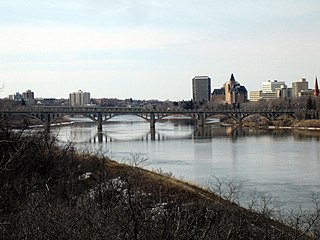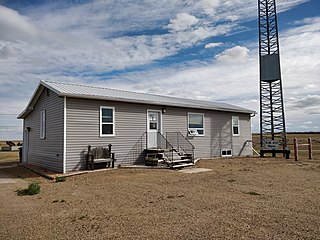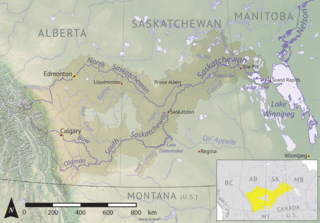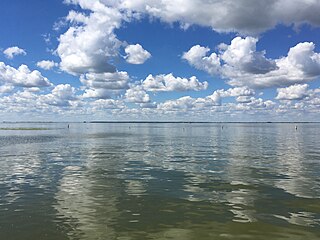
The South Saskatchewan River is a major river in the Canadian provinces of Alberta and Saskatchewan. The river begins at the confluence of the Bow and Oldman Rivers in southern Alberta and ends at the Saskatchewan River Forks in central Saskatchewan. The Saskatchewan River Forks is the confluence of the South and North Saskatchewan Rivers and is the beginning of the Saskatchewan River.

Battle Creek is a river that begins in the south-eastern region of the Canadian province of Alberta, near the border with Saskatchewan, in the Cypress Hills Interprovincial Park. From Alberta, Battle Creek flows east and across the border into Saskatchewan. It flows south out of Saskatchewan across the Canada–United States border into Montana, where it joins the Milk River in Blaine County, Montana.
Primrose Lake is a large lake in the Canadian provinces of Saskatchewan and Alberta in the Churchill River drainage basin. The lake straddles the Saskatchewan / Alberta border, with most of the water surface in Saskatchewan with only the south-west corner of the lake in Alberta. On the Saskatchewan side of the lake is Backes Island Wildlife Refuge, which is a small protected island near the middle of the lake that is important to birds. The entire lake plus surrounding land totalling 1,259.52 km2 (486.30 sq mi) is part of an Important Bird Area (IBA) of Canada.

Maple Creek is a town in the Cypress Hills of southwest Saskatchewan, Canada. It is surrounded by the Rural Municipality of Maple Creek No. 111. The population was 2,176 at the 2021 Census.

Manitou Lake is a salt lake located mostly in the RM of Manitou Lake No. 422 in the Canadian province of Saskatchewan, about 10 kilometres (6.2 mi) east of the provincial border with Alberta. The eastern shore of the lake is in the RM of Hillsdale No. 440. Manitou Lake is located in a region called the Prairie Pothole Region of North America, which extends throughout three Canadian provinces and five U.S. states. It is also within Palliser's Triangle and the Great Plains ecoregion. Manitou Lake is part of an Important Bird Area (IBA) of Canada that covers 699.66 km2 (270.14 sq mi) of land and serval neighbouring lakes.

The Rural Municipality of Big Stick No. 141 is a rural municipality (RM) in the Canadian province of Saskatchewan within Census Division No. 8 and SARM Division No. 3. It is located in southwest portion of the province.

The Rural Municipality of Reno No. 51 is a rural municipality (RM) in the Canadian province of Saskatchewan within Census Division No. 4 and SARM Division No. 3. Located in the southwest corner of the province, it is adjacent to the United States border to the south and the Alberta boundary to the west.

Torch River is a river in the Canadian province of Saskatchewan. The river's source is the dam at Candle Lake, near Candle Lake Provincial Park, and it travels east through boreal forest and muskeg en route to its mouth in the Saskatchewan River Delta. Torch River Provincial Forest, a conservation area, is located along the course of the river, near where White Fox River flows into Torch River. Torch River is a significant tributary of the Saskatchewan River and it is part of the Hudson Bay drainage basin.
Cabri Lake is an endorheic, salt lake in the Canadian province of Saskatchewan. It is located in the south-west region of the province near the border with Alberta in the Rural Municipality of Chesterfield No. 261. Cabri Lake is in the semi-arid Palliser's Triangle and can completely dry up during drought years.

Moose Jaw River is a river in the Canadian province of Saskatchewan. It is located in the southern part of the province in a region called the Prairie Pothole Region of North America, which extends throughout three Canadian provinces and five U.S. states. It is also within Palliser's Triangle and the Great Plains ecoregion.

Thunder Creek is a river in the Canadian province of Saskatchewan. The watershed of Thunder Creek is within the semi-arid Palliser's Triangle in south-central Saskatchewan. It begins at small, man-made reservoir near Lake Diefenbaker and flows in a south-easterly direction towards the city of Moose Jaw and the Moose Jaw River. The Moose Jaw River is a major tributary of the Qu'Appelle River For most of its course, Thunder Creek follows a valley called the Thunder Creek meltwater channel that was formed over 10,000 years ago near the end of the last ice age.

Oak Lake is a lake in the south-western part of the Canadian province of Manitoba in a region called Westman. Oak Lake is a kettle lake and is an aquifer supplier for numerous nearby residential areas and farms. The lake is in the RM of Sifton and sits at an elevation of 426 metres above sea level. Provincial Road 254 provides access to the lake.

Plum Creek is the primary outflow for the Plum Lakes and travels in an easterly direction for about 28 kilometres until it meets up with the Souris River, which is part of the Hudson Bay drainage basin, at the community of Souris in the Canadian province of Manitoba. Plum Lakes and the beginning of Plum Creek are in the Rural Municipality of Sifton and the mouth is in the Municipality of Souris – Glenwood.
Eyebrow Lake is a man-made marshy lake that parallels the Qu'Appelle River in the southern region of the Canadian province of Saskatchewan. Located in the RM of Huron No. 223, it is the first lake in a series of lakes along the Qu'Appelle River after Qu'Appelle River Dam and Lake Diefenbaker. The next lake downstream is Buffalo Pound Lake. The closest community is the village of Tugaske and while there are no public recreation sites at the lake, it can be accessed by Highway 627. The lake gets its name from the nearby Eyebrow Hills, which are shaped like an eyebrow. The nearby town of Eyebrow and RM of Eyebrow No. 193 are also named after these hills.

Reed Lake is an intermittent, shallow endorheic salt lake in the south-western region of the Canadian province of Saskatchewan. Most of the lake and its shoreline is designated an Important Bird Area (IBA) of Canada and it is part of a Western Hemisphere Shorebird Reserve Network (WHSRN). Access to the lake is from a lookout tower and a walking path alongside the Trans-Canada Highway, about 2.4 kilometres (1.5 mi) west of the town of Morse.

Maple Creek is a river in the south-west region of the Canadian province of Saskatchewan. The river is in the semi-arid region known as Palliser's Triangle. It begins in the Cypress Hills and flows generally in a northward direction and empties into the endorheic Bigstick Lake. The town of Maple Creek is the only notable community along the course of the river. Due to the generally dry and drought-prone conditions of the area, reservoirs were built along the river's course and in its watershed to ensure a stable water supply for irrigation. Two Important Bird Areas (IBA) of Canada cover much of the lower watershed of the river.
Ponass Lakes are made up of six shallow, marshy lake basins ranging in size from 98 ha to 1,631 ha in the central part of the Canadian province of Saskatchewan. The lakes and marsh are in the aspen parkland ecoregion and are surrounded by groves of trembling aspen and farmland. Water levels are controlled by a series of dams operated by Ducks Unlimited Canada. The outflow for the lakes and marsh is from a short creek at the north end. The creek flows into George Williams Lake, which is within the Red Deer River drainage basin. The lakes and marsh are in the RM of Ponass Lake No. 367 and access is from Highway 35.
Porter Lake is a shallow salt lake in the Canadian province of Saskatchewan. It is located in the Rural Municipality of Aberdeen No. 373, about 20 kilometres (12 mi) north-east of Saskatoon. There are no communities along the lake's shore. Access is from Ike Thiessen Road, which connects to Highways 5 and 41. The lake and the surrounding landscape is designated as an Important Bird Area of Canada.
Midnight Lake is a lake in the Canadian province of Saskatchewan. It is south of the Meadow Lake Escarpment, which is a plateau that separates the Saskatchewan and Churchill River drainage basins. The lake sits in the transition zone between the boreal forest and aspen parkland ecozones and is at the centre of an Important Bird Area (IBA) of Canada. Access is from Highway 4















